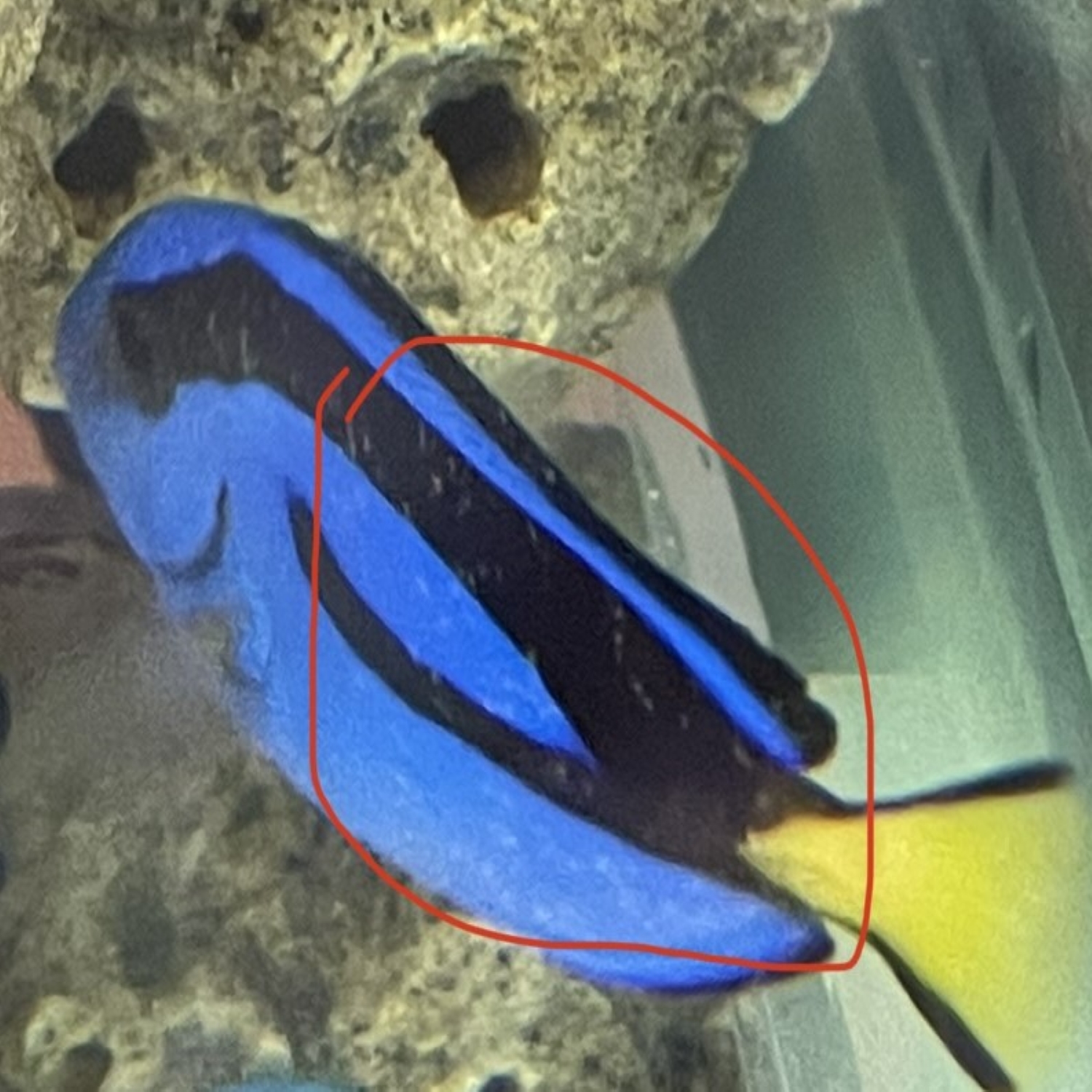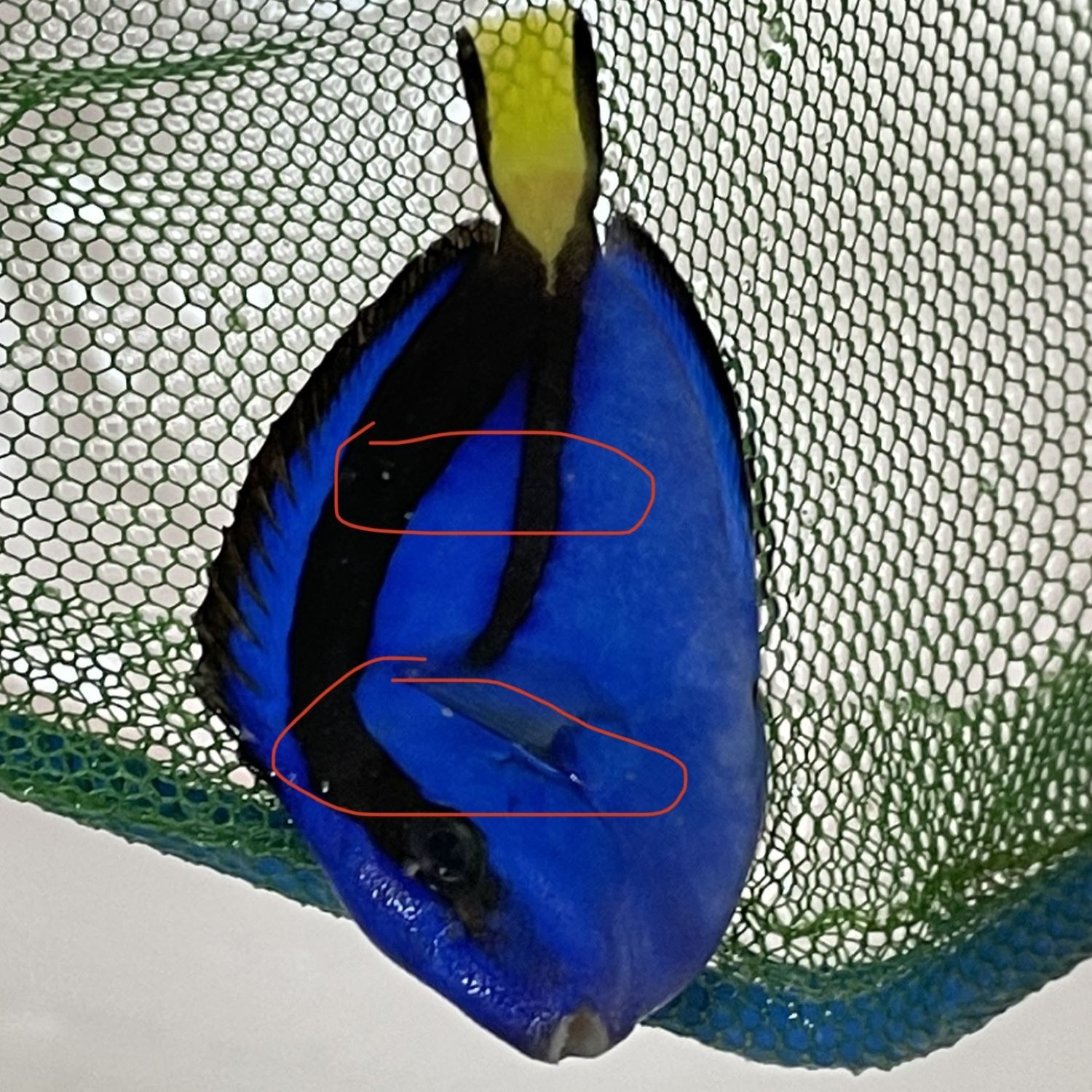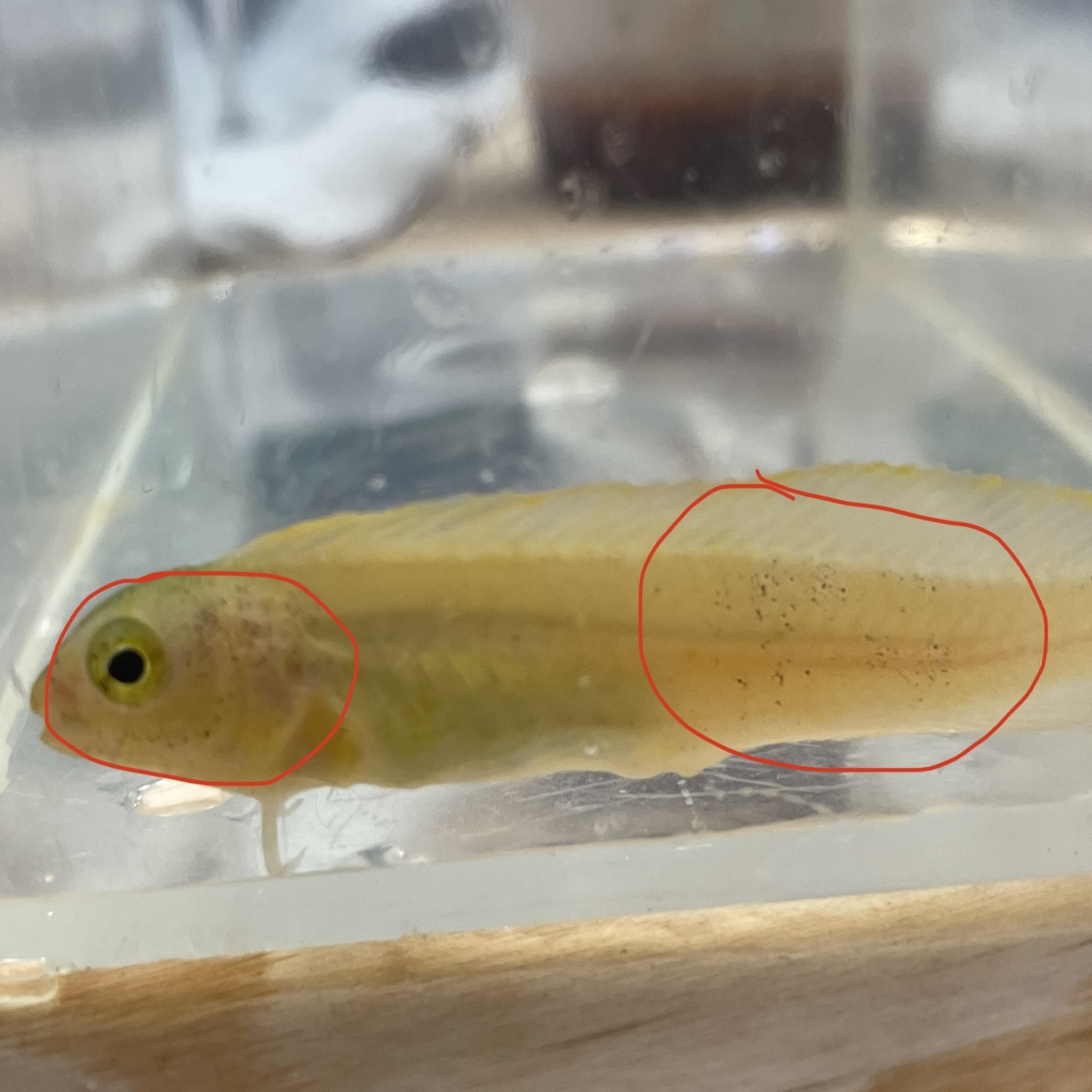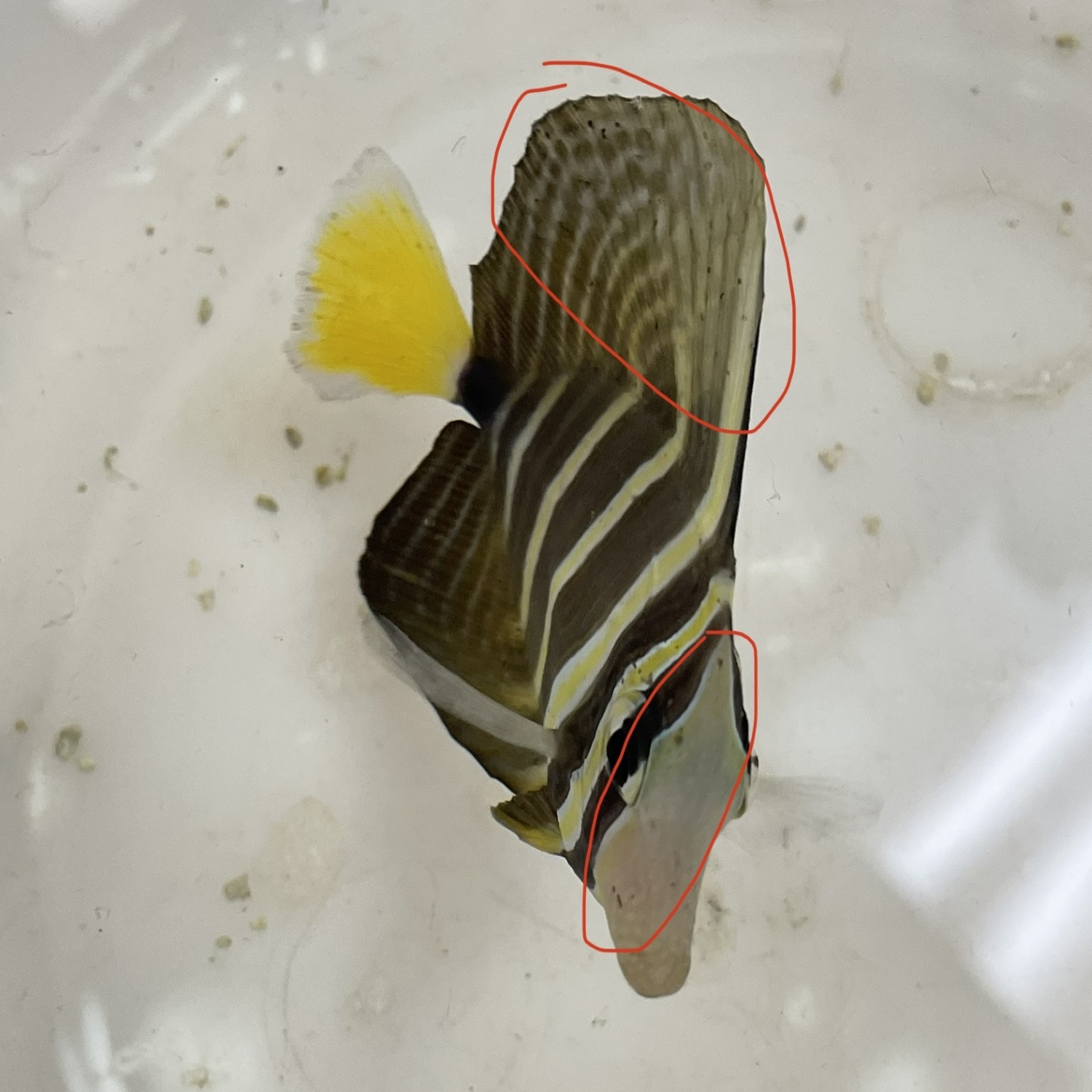Marine Velvet vs Ich
Jump to
Introduction
Marine Velvet and Saltwater Ich are the two most common diseases in saltwater fish. Marine velvet and Saltwater Ich are very similar in their physical appearance of small white dots on a fish. The difference between the two, is that Marine Velvet (Picture 1) shows powdered sugar-like grains covered over the whole body, whereas Saltwater Ich (Picture 2) has larger salt-like grains, but spaced out over the body. Marine velvet is one of the most deadly saltwater fish diseases, and it is caused by a dinoflagellate, or marine plankton. Saltwater Ich is a parasite that is very common in aquarium fish, mainly after a new fish is brought into an aquarium. Black Ich is not as common as Marine Velvet or Saltwater Ich, but it is easy to notice on a fish. This disease is black spotting on a fish body caused by a parasitic planaria as shown in pictures 3 & 4. These three diseases are all parasites attaching to a host and feeding on it, which is where the coloration comes from.
Causes of Disease
One of the many reasons these diseases develop is from stress. When we receive our fish from our wholesaler, they are stressed from traveling, and within a week our fish develop diseases such as these from the journey. Before a new shipment of fish arrives, we make sure an aquarium system is free of fish as to not overcrowd the tanks and to prevent the spread of disease. From our experience, Marine Velvet and Saltwater Ich affects all fish except sharks and rays. In the case of Black Ich, this disease affects specific types of fish such as Butterflyfish, Wrasses, Angelfish, and Tangs. Other reasons for these diseases to develop is from the fluctuating temperature, poor water conditions, and lack of adequate food quality. At Salty Underground, we do not change the temperature of our water, and we do routine water changes twice a month to prevent the spread of disease. We also feed our fish a variety of wet food in the mornings, and pellet food in the afternoon. We can attribute this new found commodity of Ich to common parasitic worms found in the ocean. We get our fish from the Pacific Ocean and the Florida Keys. We take a risk when purchasing livestock from wholesales, as fish are often infected with parasites prior to capture.
Symptoms of Marine Velvet
Marine velvet is large amounts of small powdered sugar-like grains covered all over the body, and it spreads rapidly. If a fish that has marine velvet isn’t caught quick enough, the disease will spread to the other fish in the tank, possibly killing all of the fish within 12 to 24 hours. Other symptoms of Marine Velvet are rapid breathing, swimming into the powerhead, scratching, flashing, and clouding of the eyes, skin, and fins. The Blue Hippo Tang (Picture 1) has marine velvet, and the first sign of this was the white spots on the body circled in red. Next, the fish started breathing heavily, indicating that it needed to be moved into a separate system. Hippo tangs are the most susceptible to Marine Velvet, and we pay close attention to them when they get brought into our store. When we saw the signs of Velvet, we moved it to a quarantine tank to be treated with Chloroquine Phosphate.
Symptoms of Saltwater Ich
The main sign of Saltwater Ich is white spread out spots on the body. This is different from Marine Velvet because those spots are smaller and closer together once visible on their body. Other symptoms of this disease are cloudy eyes, ragged fins, sloughing of the slime coat, and flashing. The Blue Hippo Tang (Picture 2) was infected with Saltwater Ich when it was shipped to us, and the spotting (circled in red) was our first sign that it was Ich. After further examination and seeing the spots were spread out, we knew it was Ich, and it needed to be treated with Chloroquine Phosphate. We currently have two Hippo Tangs that have Saltwater Ich, and after four days of being in Chloroquine Phosphate, the spotting on the Hippos is gone. We are currently moving these Tangs to an observation tank with unmedicated salt water to see how they look and react with no medication. After three days of being in observation, these Tangs are ready to be moved back into the general population. If we had continued to keep these fish in medicated tanks their condition has the potential to worsen. The longer fish are in medicated water, the more likely other illnesses can arise. Then, after we notice the spotting is gone, the medication has done its job, and the fish will be transferred. This will tell us if the condition still remains on the fish, or if another disease arises.
Symptoms of Black Ich
The main symptom of this disease is black spotting that appears on the fish. This is easiest to spot on light colored fish, such as the Canary Blenny (Picture 3) circled in red. This Blenny has had it rough since it has been here with us at Salty Underground. This Blenny (Picture 3) originally went into quarantine because the stomach on the fish was starting to concave because it was not eating. We treated the Blenny with medicine to rid the fish of a possible internal parasite, after that treatment ended it started to eat again.We then moved it back into the general population with the rest of our healthy fish. The Canary (Picture 3) was placed in a tank with a Cleaner Shrimp, and a Sailfin Tang (Picture 4) was introduced along with a wrasse. After those fish were introduced, we noticed the black spotting on the Canary Blenny (Picture 3), and shortly after, we noticed the fins on the Sailfin Tang (Picture 4) were not as prominent as they usually were, and under further examination, the Sailfin Tang (Picture 4) also had Black Ich, as shown on its dorsal fin on the top of its body and on its face. This is a dark colored fish, but the yellow stripes made it easy to see the Ich. These fish are being treated in Chloroquine Phosphate for eight days, and will be reassessed in two days to see if the spotting has gone down, or disappeared.
Treatment
Sometimes it can be difficult to tell whether a fish has Saltwater Ich or Marine Velvet, but fortunately, the treatment for these two diseases are the same. Formalin/malachite green, and chloroquine phosphate are the main treatment options for these two diseases. At Salty Underground, we treat our fish that have Saltwater Ich or Marine Velvet with Chloroquine Phosphate. In hindsight of our studies, we have decided to decline our use of copper and formalin/malachite green as previous fish treated with these have suffered gill damage or other harm. Formalin/malachite green we also do not use because of the effects it has on our fish. Some wholesalers dip their fish in formalin before they ship them to prevent fish from getting sick. Dipping these fish for too long in formalin can cause their gills to burn and turn red, shortening their lifespan. We treat our fish with Chloroquine Phosphate because it’s the gentlest of the three main treatments, and this medication has worked well with various types of our saltwater fish. We also treat Black Ich with Chloroquine Phosphate, but Prazipro is another medication that works well with treating this condition.
Chloroquine Phosphate
We use this medication because it has shown signs of improvement after three days of being in the treatment. When we medicate our fish with Chloroquine Phosphate, we treat them with ¼ of a teaspoon per 10 gallons, and redose the tank every three days, with a 25% water change before each new dose over the course of eight days. In addition to the Chloroquine Phosphate, freshwater dips can also be used for the parasite to die and fall off the fish. We used to medicate our fish for ten days, but after the eighth day, we found that the fish’s condition started to worsen even with the water changes. This is why we have shortened out treatment to eight days. If we can lower the treatment time with Chloroquine Phosphate, it will give the fish a better chance of survival. We have found that this medication does work and will continue to work for us at Salty Underground.
Conclusion
Marine Velvet, Saltwater Ich, and Black Ich are some of the most common diseases that affect our fish at Salty Underground. The way to differentiate these diseases are the sizes and colors of dots. Small, white dots that are close together are Marine velvet. Large, white dots that are spread apart are Saltwater Ich. Black Ich are small black dots on the body. We treat these diseases the same way with Chloroquine Phosphate, and Prazipro is also a medication used for Black Ich. Chloroquine Phosphate is a dose of ¼ teaspoon per ten gallons of water, redosing every three days with a 25% water change for eight days. We started our Chloroquine treatment for ten days, but after eight days, the fish showed improvement and can be moved to an observation tank in unmedicated water. We are in the process of shortening our treatment time from eight days, as our Hippo Tangs have shown that the treatment works after four days. These diseases are easy to catch, and we have success with our fish in this treatment, and we continue to have success with this medication.
By: Sarah Cooley
References
Goemans, Bob, et al. 2008, The Marine Fish Health & Feeding Handbook: The Essential Guide to Keeping Saltwater Species Alive and Thriving. Microcosm/T.F.H. Publications, retrieved [July 27].




